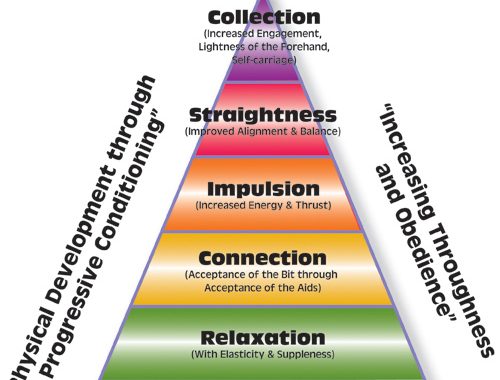Shoulder Fore
Shoulder Fore Defined
An exercise that moves the horse’s shoulder to the inside similar to shoulder in. The angle of shoulder fore is approximately 1/2 that of the shoulder in. This exercise can be used by the rider to improve the suppleness of a young or stiff horse.
How to Execute the Shoulder Fore
Start in working trot – sitting
Ride a volte in the corner of the arena at the beginning of the long side.
While circling, increase the inside leg and outside rein aids. The inside leg remains active at the girth. The outside leg is slightly behind the girth to prevent the haunches from swinging out.
Maintain the bend and proceed down the long side bringing the forehand off the track.
Once the shoulders and forelegs have left the track, increase the outside rein aid to prevent the horse from overbending to the inside.
The shoulder fore can be completed by either riding forward on the curve across the arena or by straightening by bringing his shoulders back to the track. The latter is a more advanced completion of the movement; whereas, the former rewards and encourages the horse. Either can be used depending on the level of training.
Notes:
Do not rely on your inside rein to move the horse’s shoulders in from the track. Rather concentrate training your horse to go off your inside leg. The horse should travel from the inside leg to the outside rein. The inside rein must remain soft.
It is essential that the rider sit in the center of the horse and look between the horse’s ears, so as not to through the horse off balance.
The rider’s shoulders should be parallel to the horse’s shoulders.
The rider must be fluid and move with the horse. If the rider is stiff, the horse will have to work much harder to achieve the movement.
Purpose of the Shoulder Fore
To improve the suppleness of the horse.
To develop straightness in the horse’s body.
To introduce and improve the horse’s responsiveness to directional aids.
To balance the horse.
To increase the horse’s acceptance of the outside rein from the inside leg.
To aid in keeping the horse correctly on the bit.
To improve the rider’s awareness of the horse’s degree of flexion, bend and straightness.
Common Errors in Execution
The horse’s hindquarter shifts to the outside rather than the forehand coming in from the track.
The rider relies too heavily on the inside rein when asking the horse to move his shoulders inward from the track.
There is variation in the angle throughout the exercise.
The rider asks for too much angle, thus performing a shoulder in.
The rider does not provide enough outside rein contact or has too much inside rein contact, thus causing too much bend in the horse’s neck.
The horse becomes tense in the movement.
Author: Dressage Academy
The Shoulder In
Stretch Down Circle
You May Also Like

Rhythm – Let’s Get into the Groove Newsletter
March 28, 2018
Food for Thought
July 10, 2017